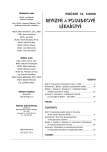A review of medical studies on drug interactions and risk combination of drugs in prescription of physicians
Authors:
M. Prokeš
Authors‘ workplace:
Infopharm, a. s., Praha
Published in:
Listy rev. Lék., 13, 2009, č. 1, s. 3-15
Overview
Drug interactions are one of the main risks of pharmacotherapy in all advanced countries of the world. In this article, a review of studies identifying the incidence of drug interactions and other risk combinations of drugs is presented. The study in Great Britain found that 6,5% of hospital admissions were caused by adverse drug reactions, of which 16,6% were caused by drug interactions. Even higher rate of drug interactions was detected in patients admitted to the intensive care unit in one of the New York hospitals. Furthermore, the review of nine studies is presented, which describes data collection and data evaluation of the follow-up of risk prescription at the out-patient medical practice and also methods of influencing prescription of physicians with the aim to increase the safe treatment in France, USA, Great Britain, Canada, Czech Republic, Spain and Israel. In some of these studies, the support of rational pharmaco-therapy is described. In the discussion to these findings, some methods are proposed to increase safety of pharmacotherapy in the Czech Republic.
Key words:
drug interactions – safety of pharmacotherapy – identification of risk prescription – database of prescribed drugs
Sources
1. Lazarou, J. et al. Incidence of Averse drug Reactions in Hospitalized Patients. A meta-analysis of Prospective Studies. JAMA, 1998, 279, p. 1200–1205.
2. Kvasz, M. et al. Averse Drug Reactions in Hospitalized Patients: A Cirtique of a meta-analysis. MedGenMed, 2000, 2, 2, E3;.
3. Pirmohamed, M. et al. Averse drug reactions as cause of admission to hospital: prospective analysis of 18 820 patients. BMJ, 2004, 326, p. 15–19; .
4. Rivkin, A. Admissions to medical intensive care unit related do averse drug reactions. Am. J. Health Syst. Pharm., 2007, 64, p. 1840–1843.
5. Vademekum lékových interakcí INFOPHARM (www.drugagency.cz), aktualizace z ledna 2008.
6. Guédon-Moreau, L. et al. Absolute contraindications in relation to potential drug interactions in outpatient prescriptions; analysis of the first five milion prescriptions in 1999. Eur. J. Clin. Pharmacol., 2004, 95, p. 899–904.
7. Régime Général, Mutualité Sociale Agricole a Régime d’Assurance Maládie des Professions Indépendantes.
8. Curtis, L. H. et al. Prescription of QT-Prolonging Drugs in a Cohort of About 5 Million Outpatients. Am. J. Med., 2003, 114, p. 135–141.
9. Nykamp, D. L. et al. Ann PHarmacother, 2005, 39, p. 543–546.
10. Tepper, S. et al. Coprescription of Triptans With Potentially Interacting medications: A Cohort Study Involving 240 268 Patients. Headache, 2003, 43, p. 833.
11. Peng, C. C. et al. Retrospective Drug Utilisation Review: Incidence of Clinically Relevant Potential Drug-Drug Interactions in a Large Ambulatory Population. J. Managed. Care Pharm., 2003, 9, p. 513–522.
12. Solberg, L. I. et al. Measuring Patient Safety in Ambulatory Care: Potential for Identifying Medical Group Drug-Drug interaction Rates Using Claims Data. Am. J. Managed. Care, 2004, 10, p. 753–759.
13. Chen, Y. F., Avery, A. J., Neil, K. E., Johnson, C., Dewey, M. E., Stockley, I. H. Drug Saf., 2005, 28, 1, p. 67–80.
14. Tamblyn, R. M. et al. Do too many cooks spoil the broth? Mutliple physician involvement in medical management of elderly patiens and potentially inappropriate drug combinations. Can. Med. Assoc. J., 1996, 154, 8, p. 1177–1184.
15. Tamblyn, R. et al. The medical office of the 21st century (M0XXI): effectiveness of computerized decision-making support in reducing inappropriate prescribing in primary care. CMAJ, 2003, 169, p. 549–556.
16. Morera, T. et al. Evaluation of a Drug-Drug Interaction Alert Structure through the Retrospective Analysis of Statins-Macrolides Co-Prescriptions. Basic Clin. Pharmacol. Toxicol., 2005, 96, p. 289–294.
17. Halkin, H. et al. Preventing drug interactions by online prescription screening in community pharmacies and medical practices. Clin. Pharmacol. Ther., 2001, 69, p. 260–265.
18. Haaijer-Ruskamp, F. M. Measuring effects of interventions to improve prescribing. Sdělení na Eurodrug Prague 2001.
19. Prokeš, M. et al. Výskyt lékových interakcí u klientské zaměstnanecké pojišťovny Škoda. Prakt. Lék., 2005, 85, s. 457–460.
Labels
Medical assessment Occupational medicineArticle was published in
Revision Medicine Journal

2009 Issue 1
Most read in this issue
- Physician reviewer and gynaecology
- A review of medical studies on drug interactions and risk combination of drugs in prescription of physicians
